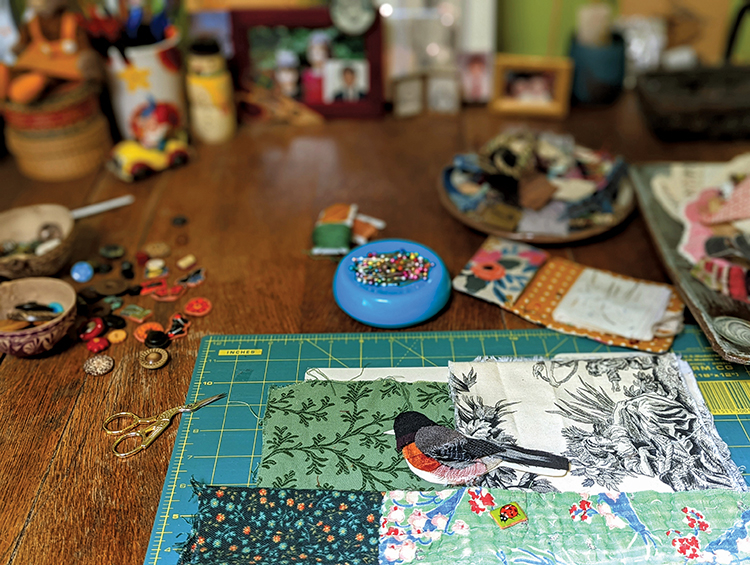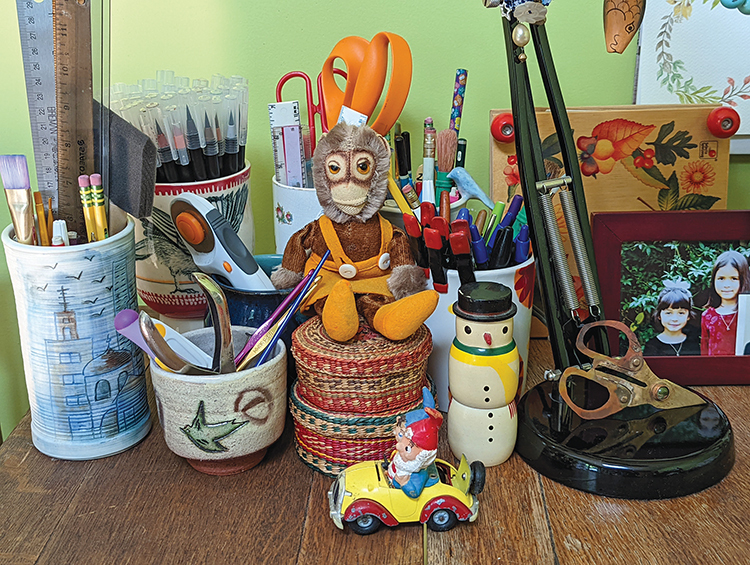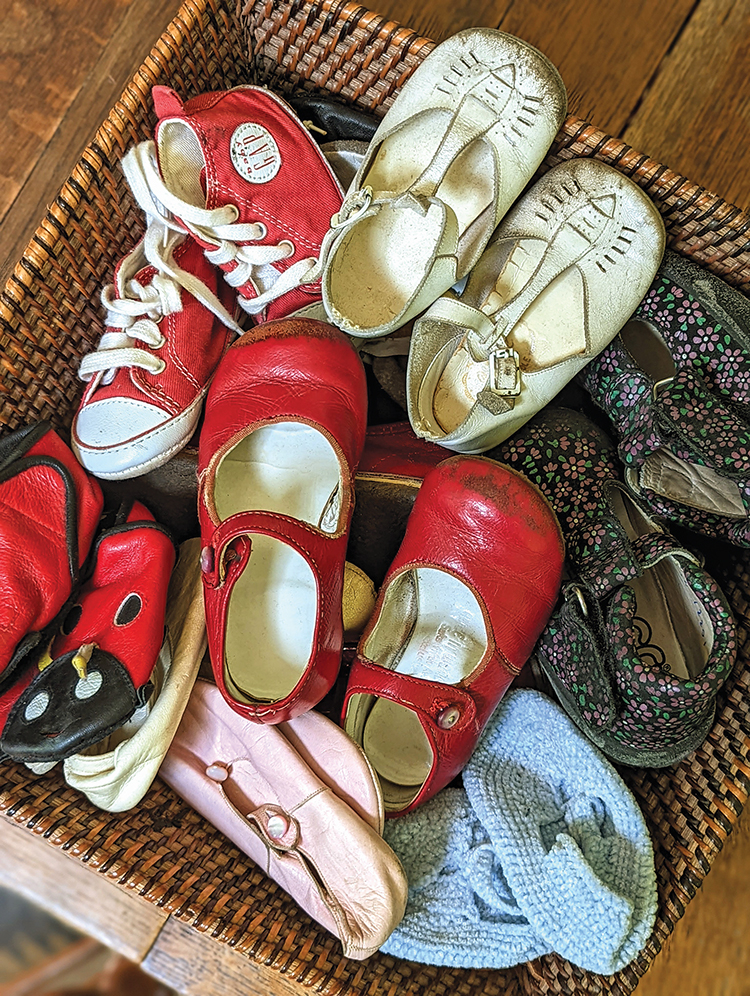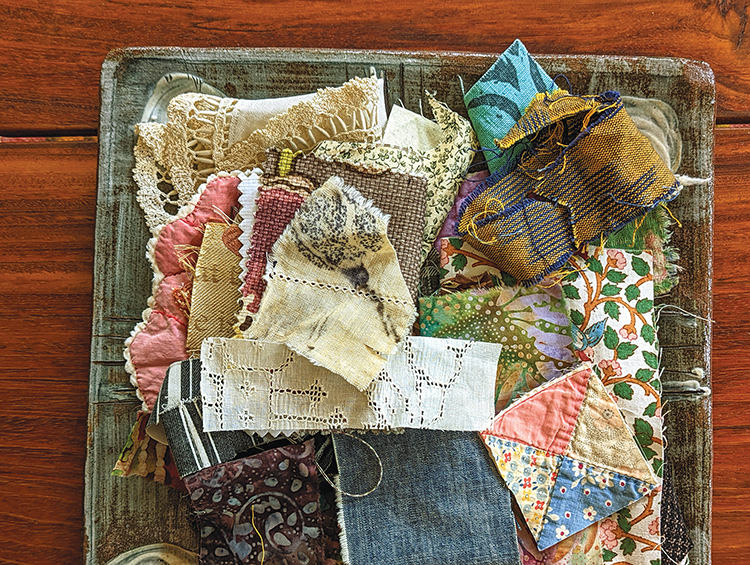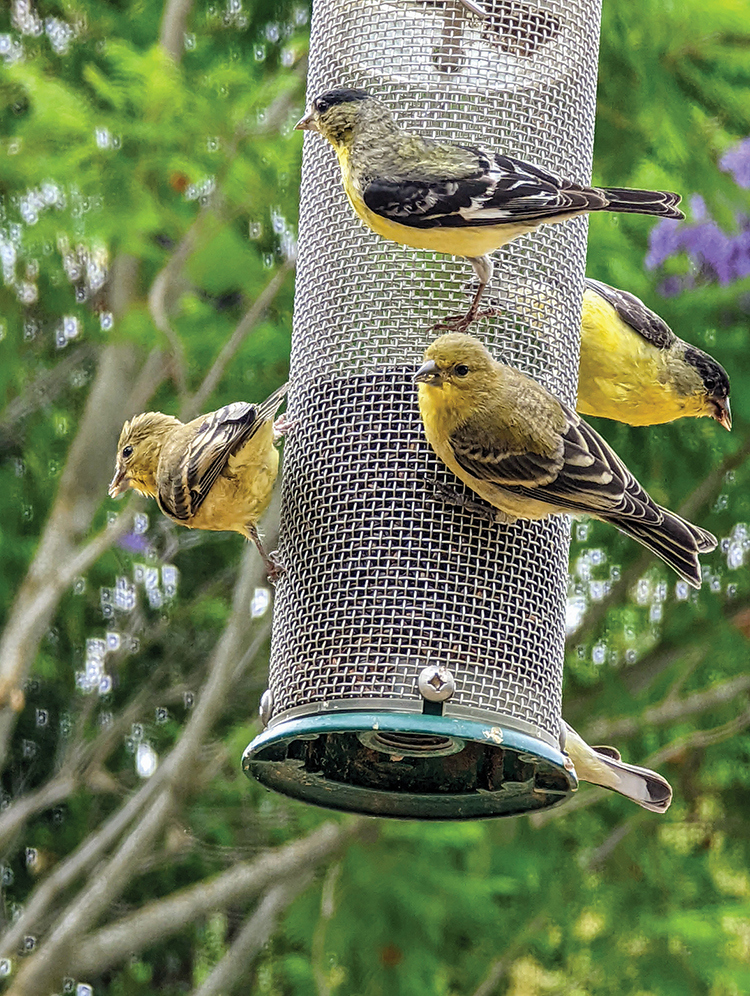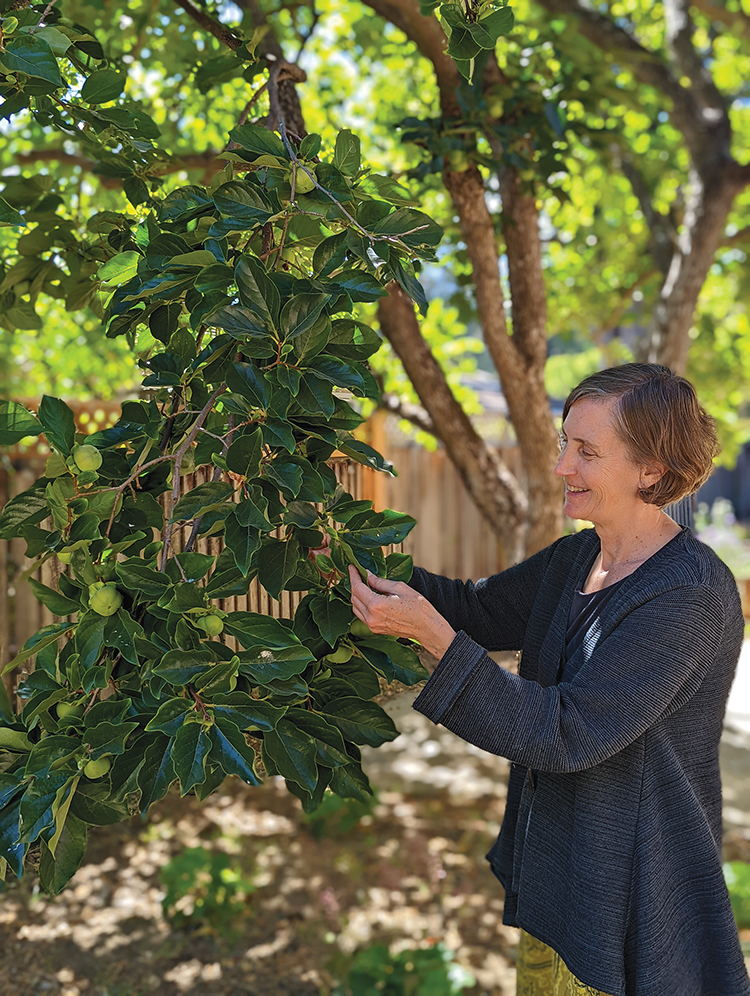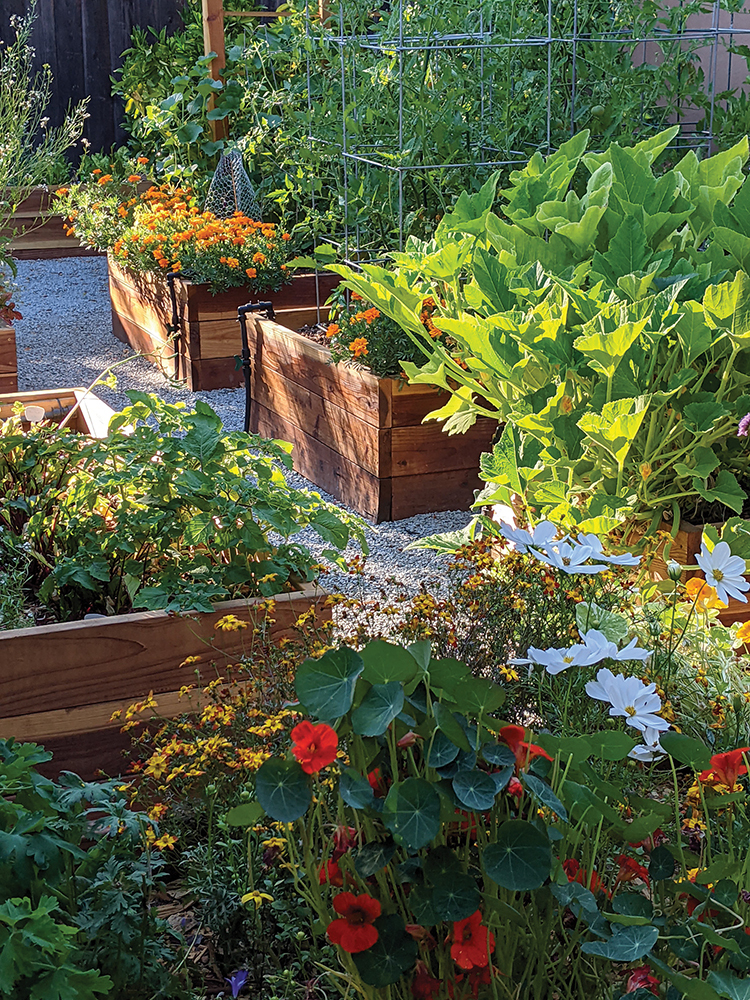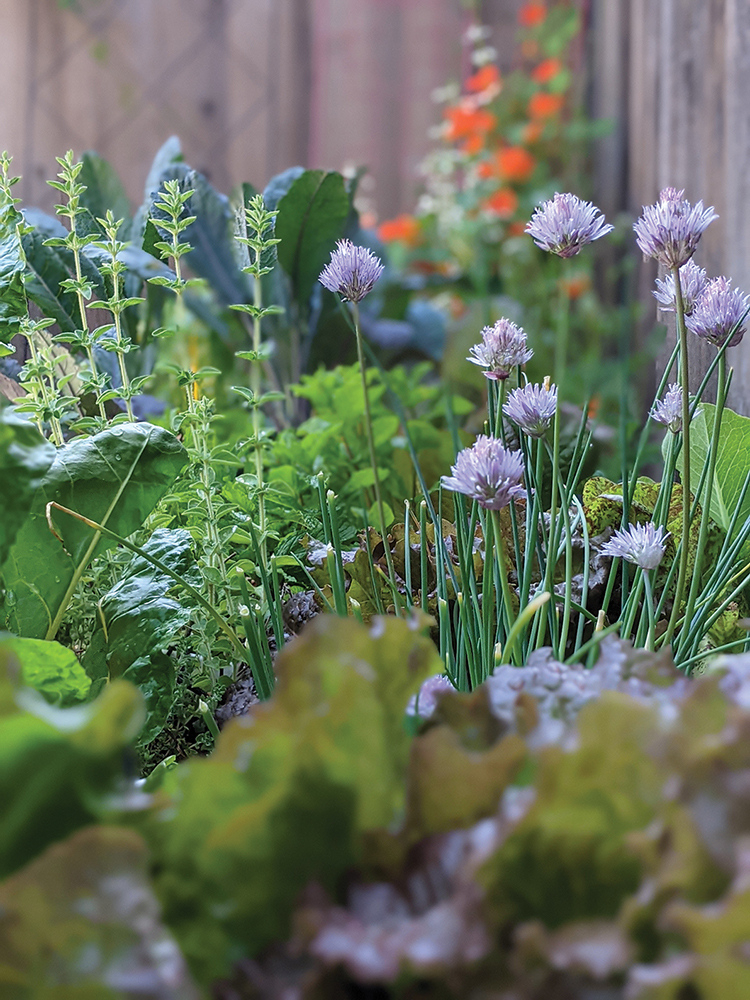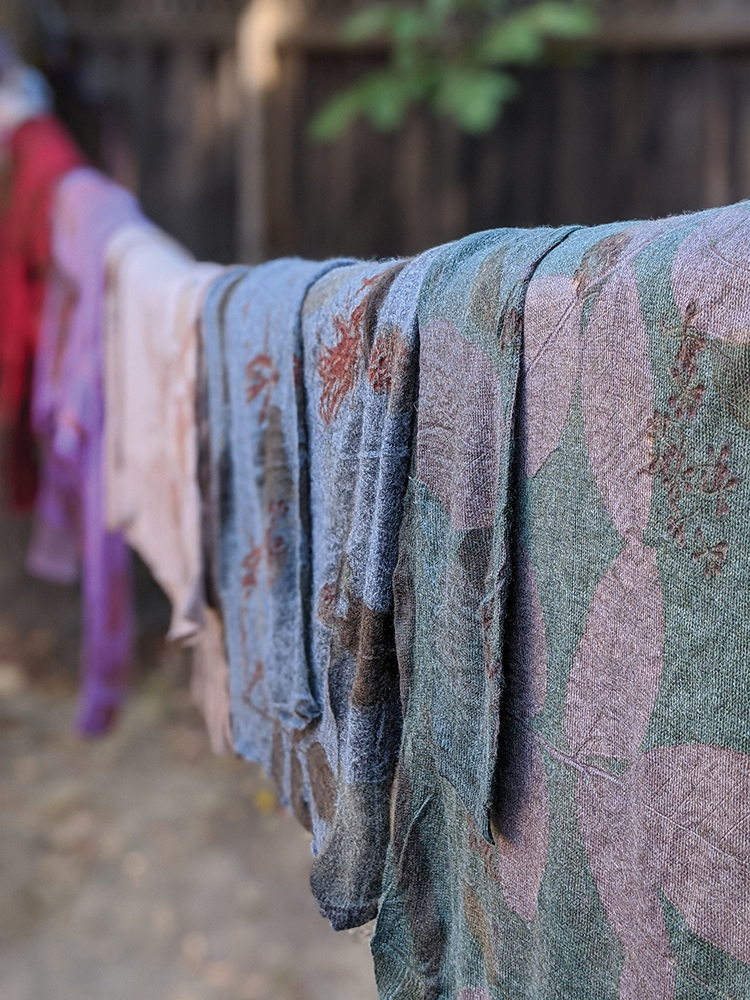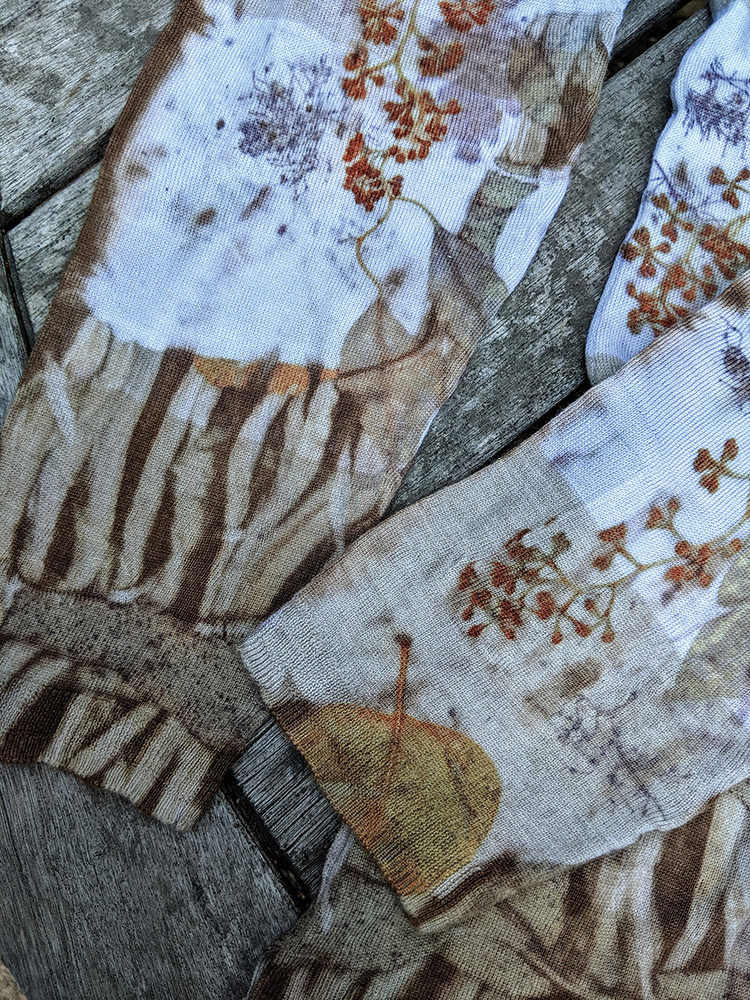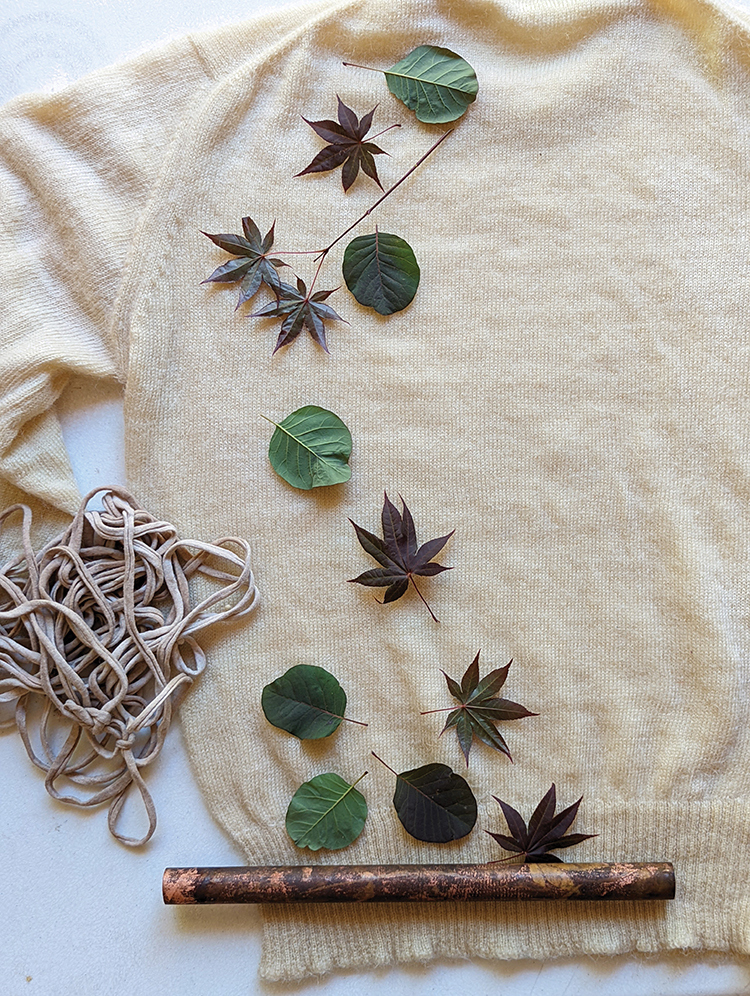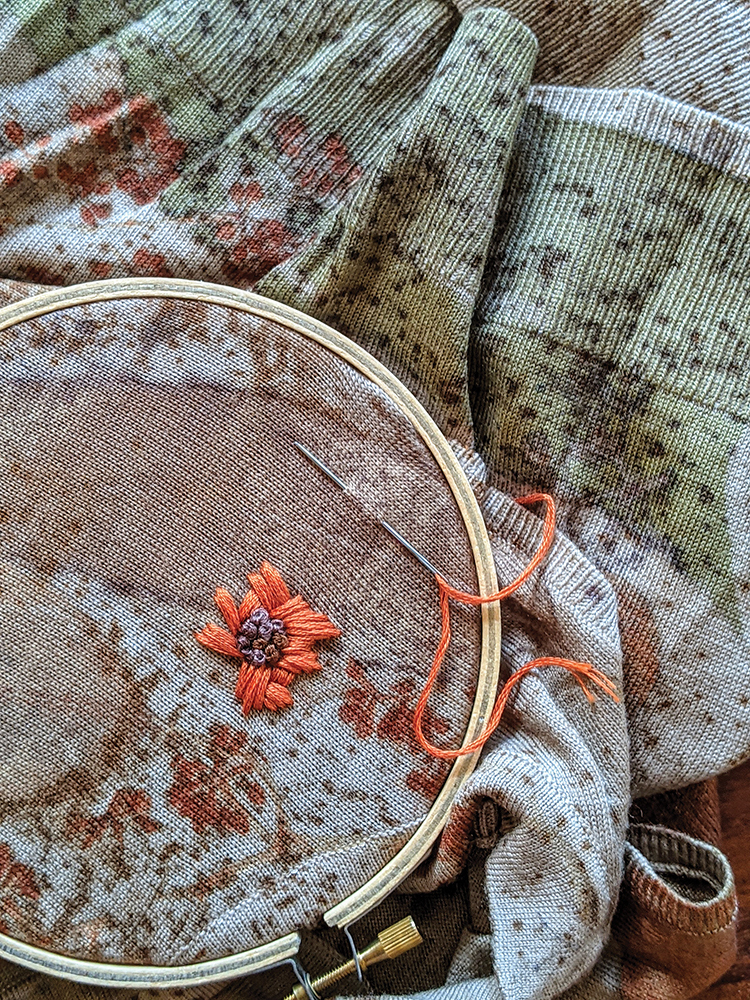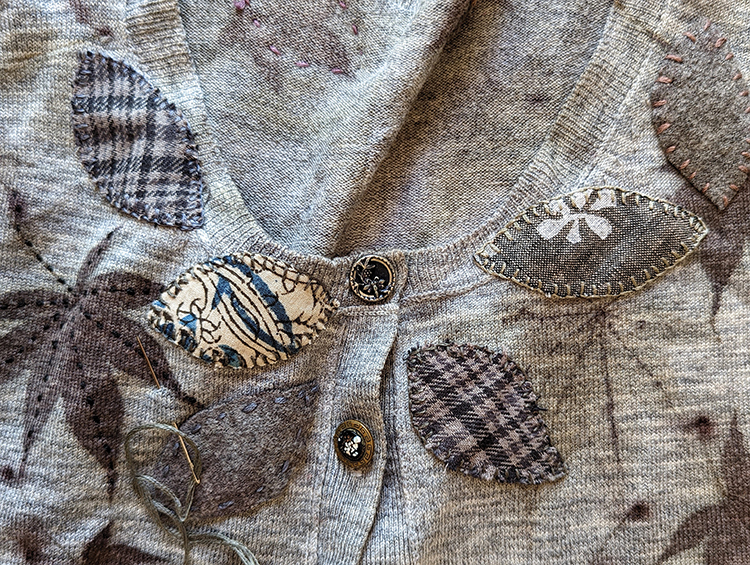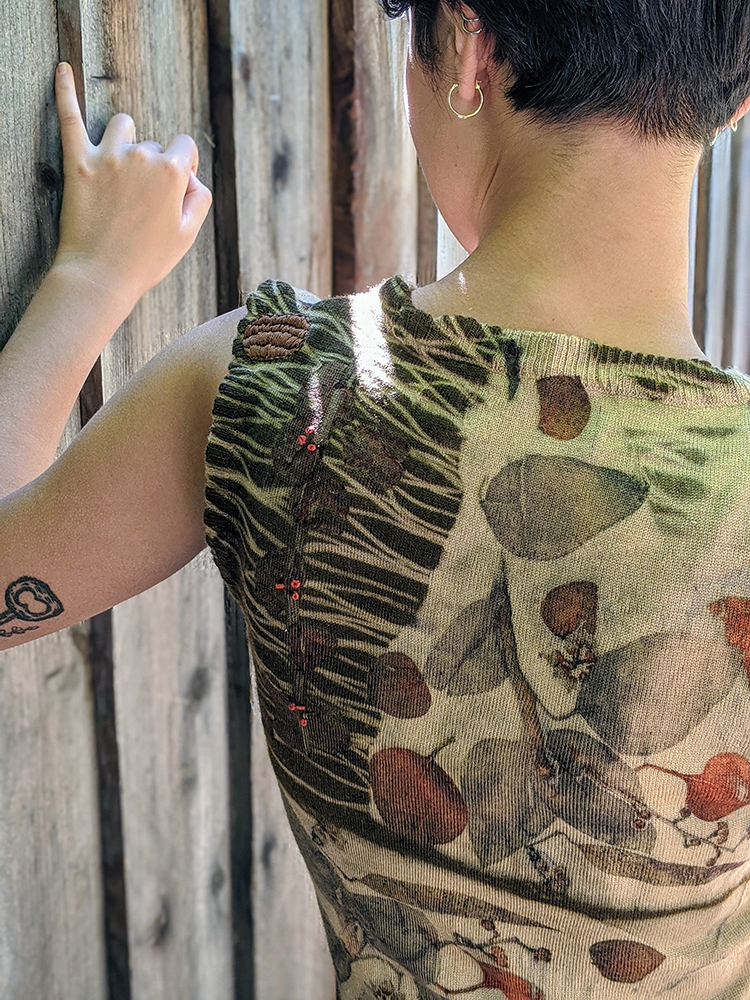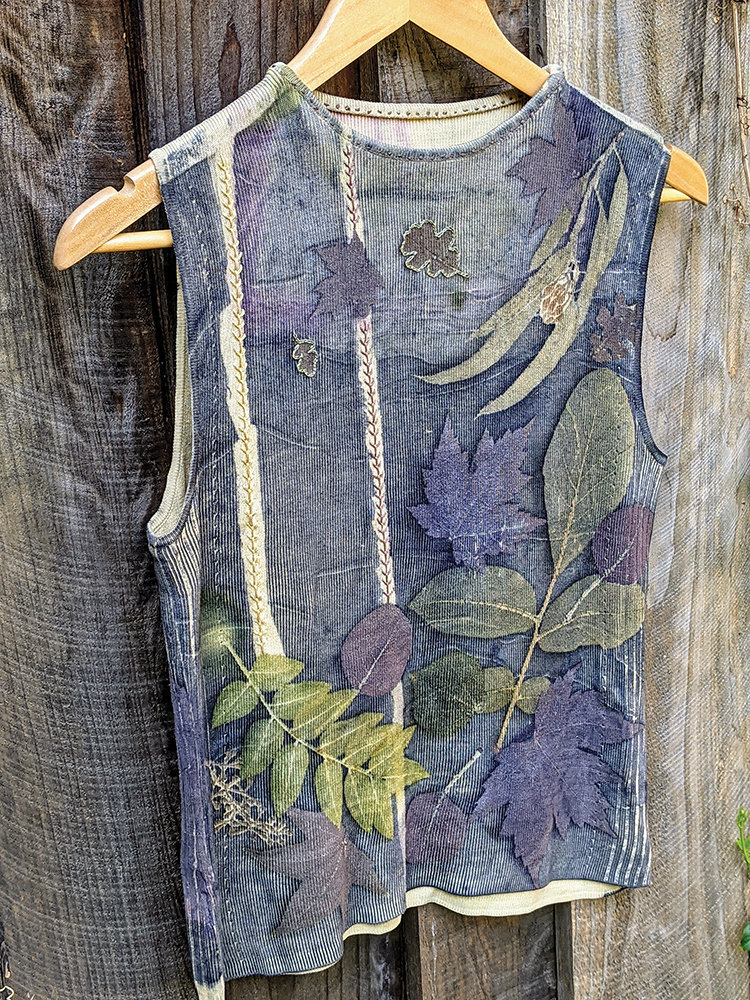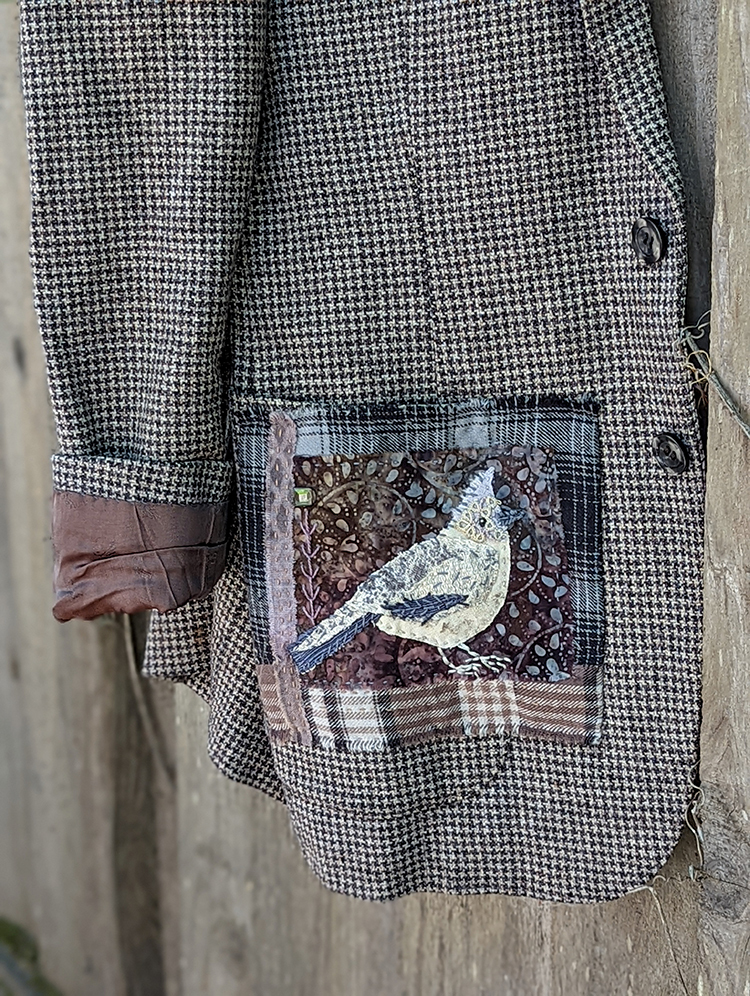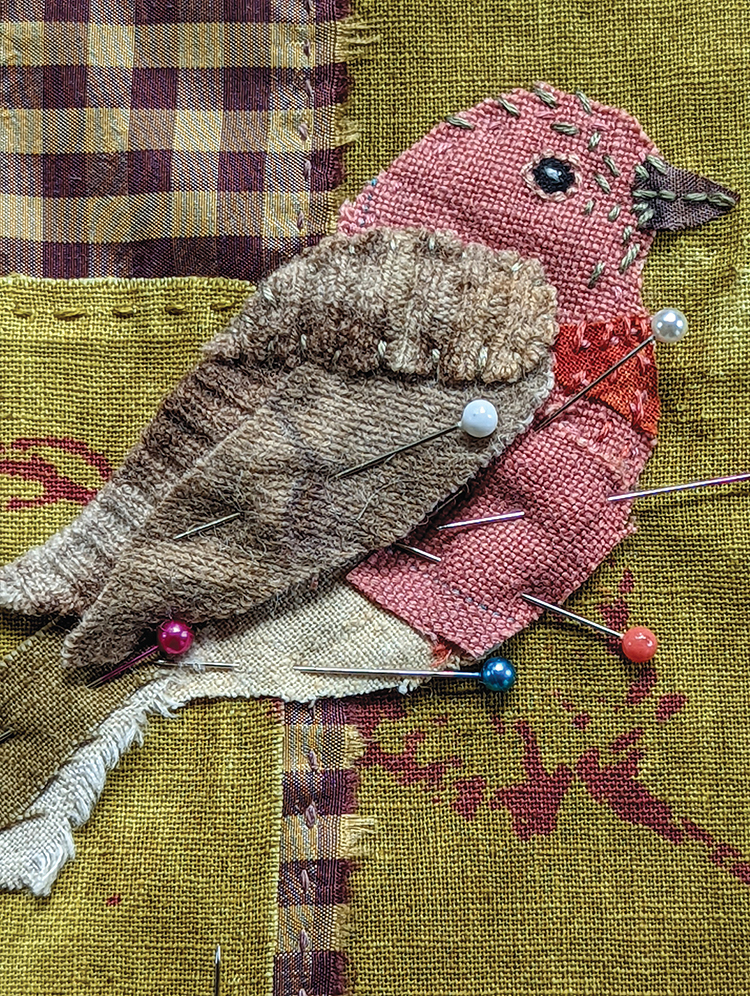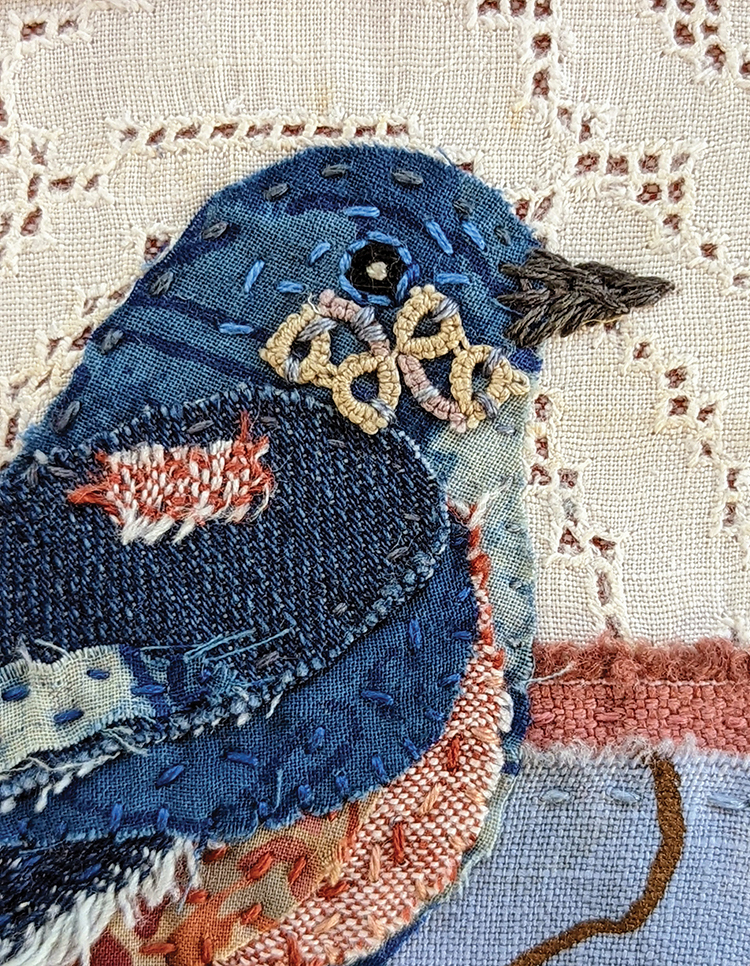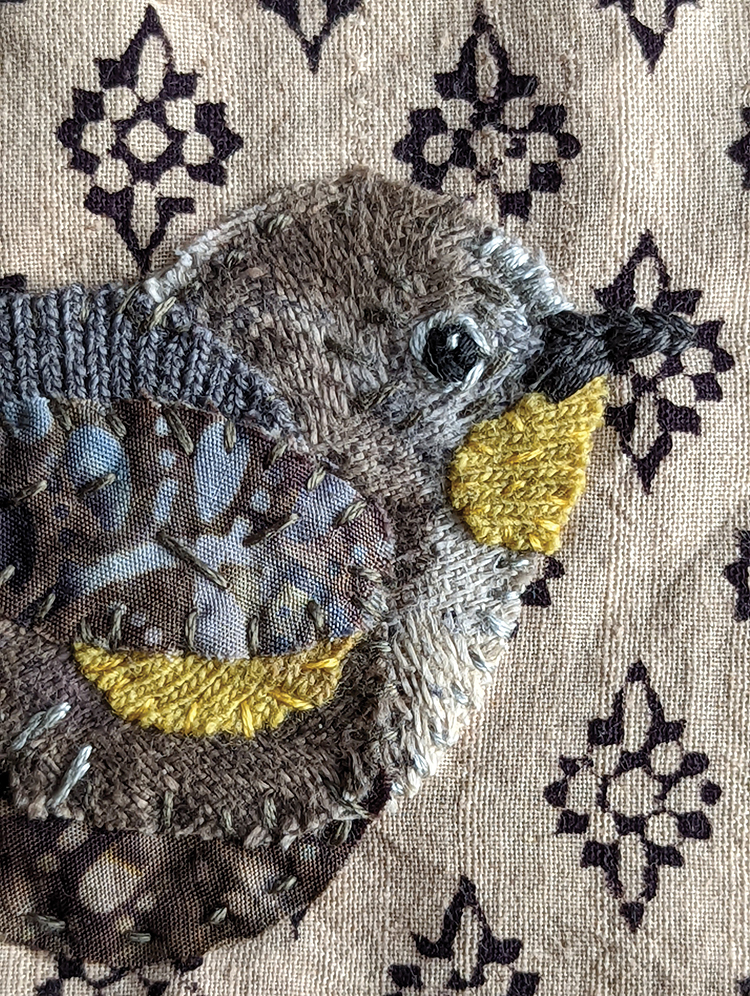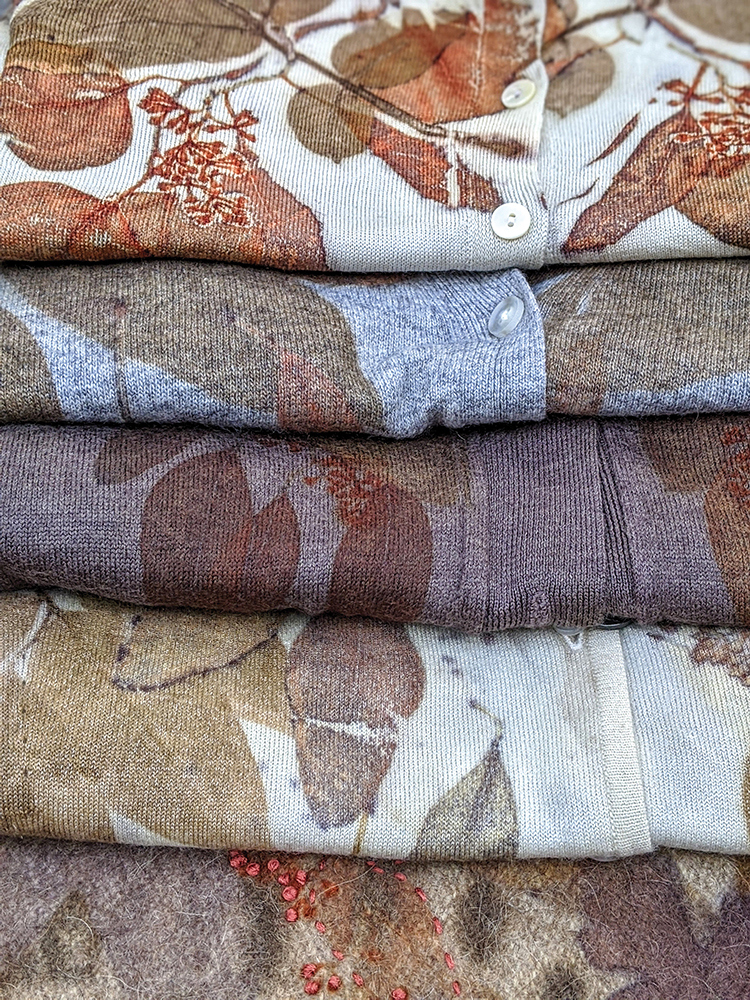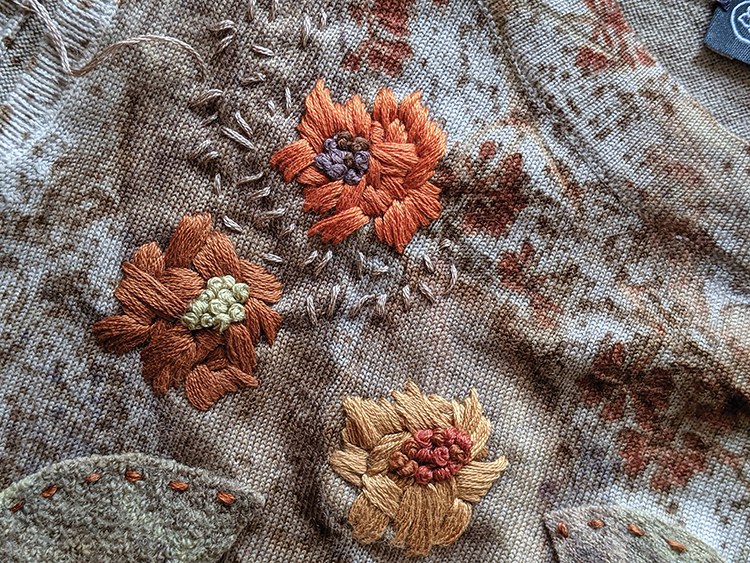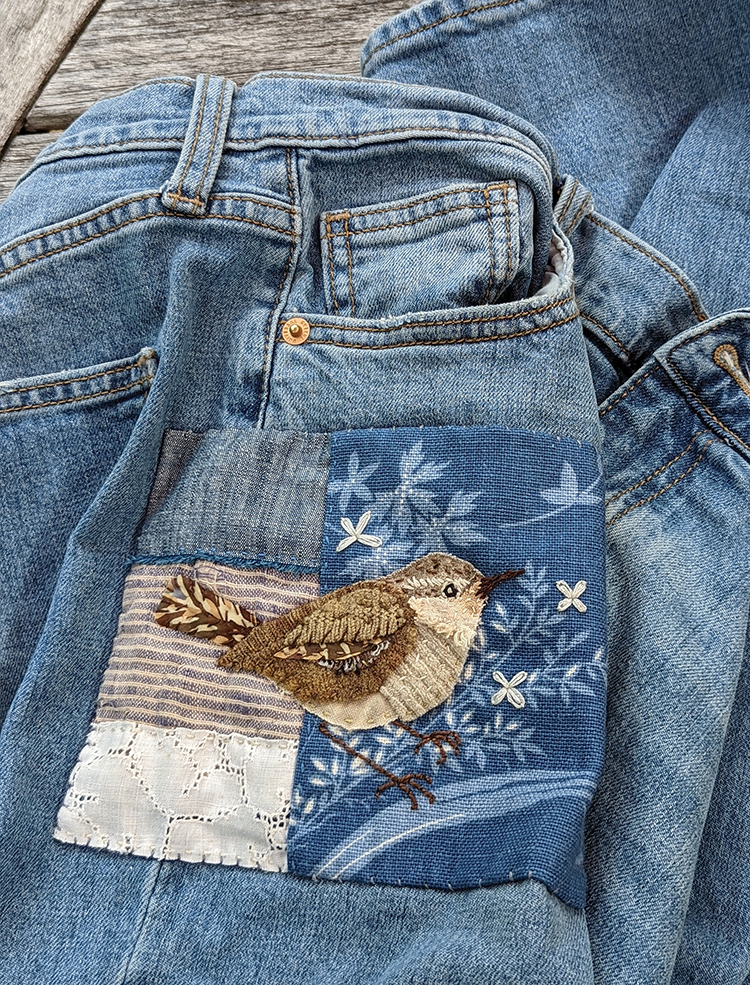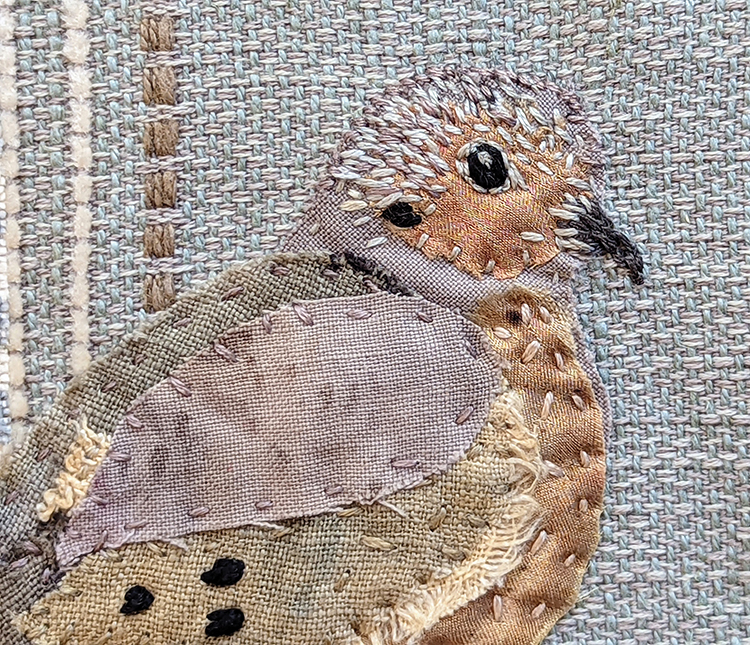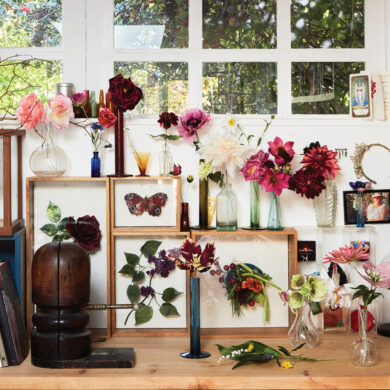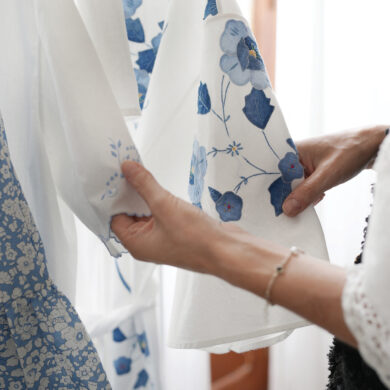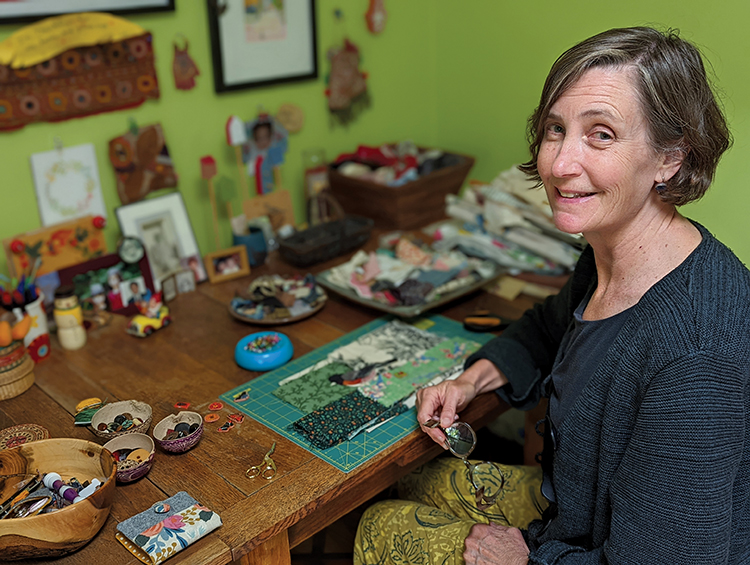
Journey
If fuzzy memories are any indicator, my interest in wearable art started early. There I am, little preschool me, joyfully smearing fingerpaint with both hands. And not just on paper but clothing and possibly even walls, too. I feel like a party dress was involved, but maybe that’s just how I choose to remember it, since wearable art has occupied much of my creative energy over the years. One thing I do know is that creating art to wear feels as natural to me as painting a picture to hang on the wall. The art we create expresses who we are and how we see the world. What better way to embrace that than dressing up in our art for all to see?
Finger painting aside, the foundation for my wearable art dates back to when my grandmother pulled me on her lap and taught me to stitch. She had an abundance of patience, as grandmothers often do, and a winning strategy. First, she captured my attention with the decorative stitches, then came the hemming and buttons. A yellowing sampler she inspired still hangs in my studio. “Ann Smith, 8 years old,” it proudly proclaims in colorful, if slightly lopsided, chain stitch.
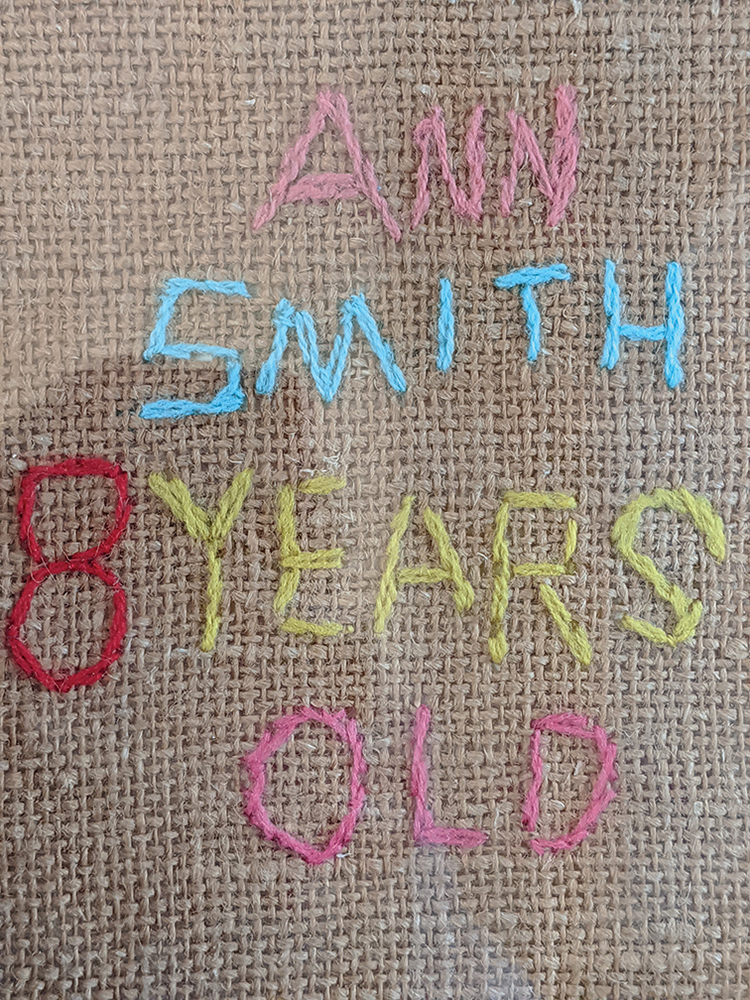
My mother kept a mending pile in an old wicker basket. It was actually less a pile, more a mountain, forever in danger of an avalanche. As soon as she recognized my interest in stitching, the mountain was my domain. And that was fine with me. Mom trusted me with the job, which meant adding my own flair. That mending pile was my first introduction to repair as self-expression — decades before we had any notion of “visible” mending the way we do now.
One summer, my best friend’s mother taught us to operate a sewing machine. Using a shared Simplicity pattern, we stitched calico jumpsuits with zipper fronts (it was the 1960s, after all). Those were the days of handlebars with streamers, and we made a statement biking the neighborhood in our handmade flower-power outfits. Wearable art might be stretching it, but the seeds were sown nonetheless.
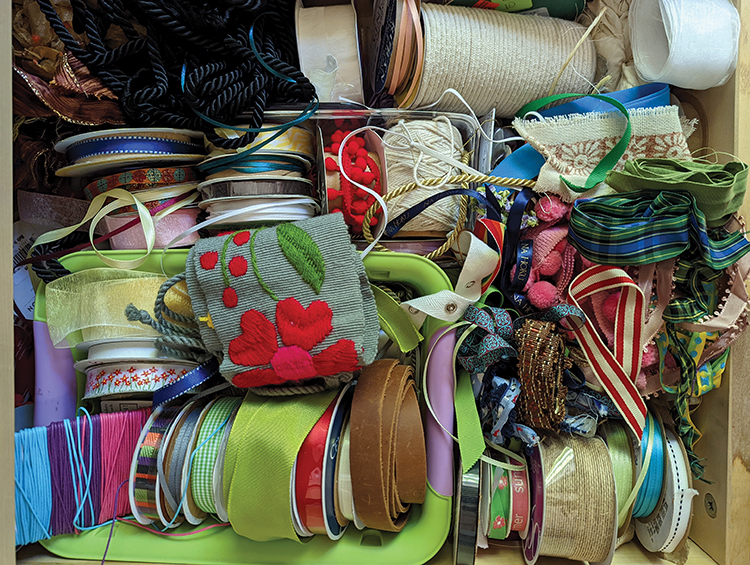
I’ve been collecting interesting materials since I was a teenager and incorporating them into my work: fabric and buttons, ribbon and lace, vintage clothing and linens. I stitched coats from salvaged patchwork quilts; trimmed hand-sewn fleece jackets with batik prints and Bakelite buttons; and created handbags from hand-woven sari remnants. The notion of my work as art didn’t always occur to me. I simply made what I wanted to wear.
My current passion is repairing and upcycling garments I find in thrift shops, giving them a new look and another chance at life. We know so much now about the negative impacts of the fashion industry. And as someone who creates things to wear, I believe it’s important to think carefully before adding more to a world that’s already filled with clothing. It’s astonishing to see what people discard — cashmere sweaters with the tiniest stains, jeans with minimal wear. These castoffs are the basis for my art now. I sometimes wonder if my early interests were leading me here all along.
“Said the river: Imagine everything you can imagine, then keep on going.”
— Mary Oliver
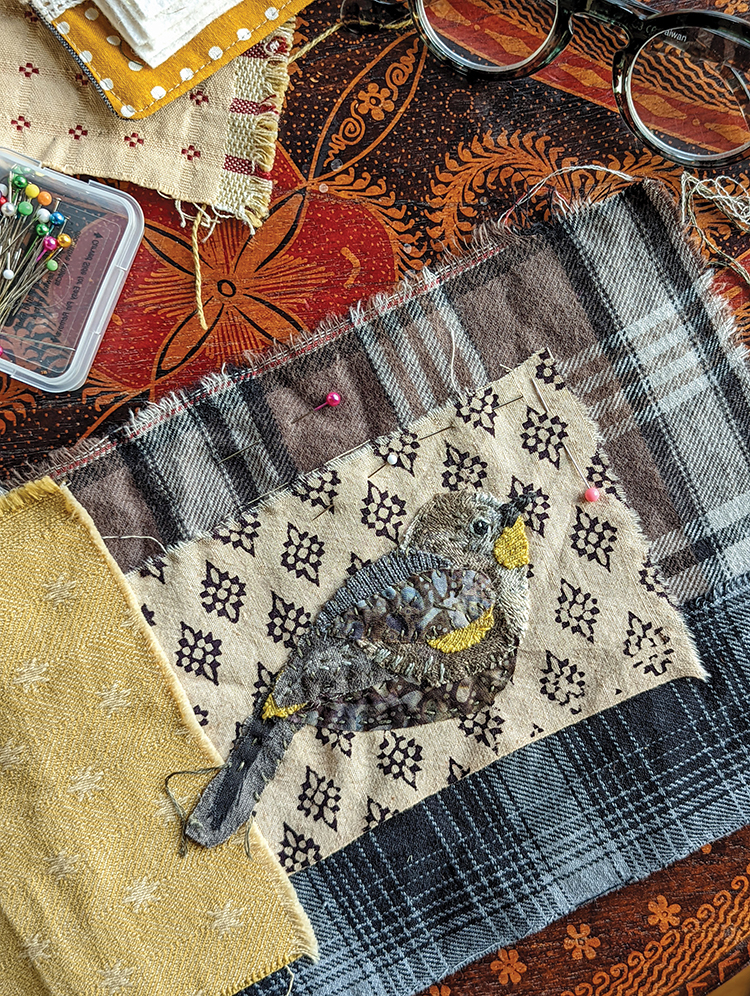
I use various techniques to reimagine old garments. Sometimes I print on them with leaves I collect in our garden, using a process called botanical printing. I also repair worn areas with embroidery or patches. Sometimes I even cut them into pieces and rework them into something completely new, like a scarf or purse.
Reimagining an outdated garment is rarely a linear process from start to finish. There’s a lot of trial and error involved. I might start with a vision, but inevitably the vision evolves, sometimes unexpectedly, as I go along. Often I stitch an area only to rip everything out the very next day. Those moments are frustrating. But when I embrace the mistakes, the results are always better. Mistakes offer the best learning opportunities. I love the detours, when something happens that makes me completely question what I’m doing, and I end up taking an entirely different path. That’s what makes the creative journey so rich. I just need to remember to take a deep breath, trust my instincts and then jump in.
My work often incorporates hand stitching. I’m drawn to the meditative qualities of sewing slowly by hand. There’s something alluring about a project you hold in your lap that doesn’t require equipment or setup. It’s quiet and uncomplicated — soothing to mind and body. And when the stitching involves mending, there’s a whole other dimension. When I mend, I feel better, as if I’m somehow mended in the process, too.
I never know exactly where my art will take me next, but one thing I do know is that we live in uncertain times when so much feels beyond our control. I focus on what I can do, even if that’s only reimagining one garment at a time. I believe art can make a difference, and I want to be part of that.
Studio
My studio is the bedroom our daughters once shared. It’s the place where we used to create together when they were young, and the evidence remains: the sprinklings of glitter and the safety scissors. I love to surround myself with artifacts from my life and travels. It fuels my creativity.
Artwork and mementos hang on walls that are painted a bright Granny Smith-apple green. Childhood toys and a basket of baby shoes nestle next to jars of pens, pencils, scissors and paintbrushes. A bookshelf filled with how-to books stands in a corner next to a tower of bins stuffed with my voluminous and ever-expanding fabric collection. You’ll find containers everywhere, filled with odds and ends like buttons and beads, ribbon and thread. I collect things for my art — upcycled things — and my studio is filled to overflowing. My studio is a warehouse of sorts. I create here, but it’s also where I keep my supplies. When I need more room to work, I often move out to the dining room table.
Garden
I think of our garden as an extension of my studio. It’s where I find my inspiration, whether that’s the birds I applique or the leaves I embroider. It’s also where I do my leaf printing. And in the morning, you’ll often find me sitting near our persimmon tree listening to the birds with a cup of tea and some hand stitching.
“All my life through, the new sights of nature made me rejoice like a child.”
—Marie Curie
Wearable Art
When I sit down to reimagine a garment, I rarely have a set outcome in mind. Each garment comes with a story — and sometimes even a sewn-in name tag. My task, as I see it, is to add a new chapter.
One of my favorite ways to cover wear and tear, especially stains, involves printing over them with leaves. The technique, botanical printing, transfers the natural dyes in leaves to fabric. Basically, you roll leaves up in a pre-mordanted garment, then apply heat to transfer the natural dye and prints. It’s absolutely stunning. For lasting results, it’s important to follow a prescribed process; and if you want to learn more, I suggest starting with a class.
Once I’ve printed a piece, it’s time to repair the holes. I like to celebrate a garment’s longevity and service by drawing attention to the mending. Many of us call this visible mending, and unlike the mending my grandmother taught me, this mending stands out. It makes a statement. I carefully stitch or darn the hole. Then I add nature-inspired embroidery on top.
Patching is another great way to mend — and to use up even the tiniest fabric scraps. I love using leaf patches in my work, and during the pandemic, I started creating appliqued bird patches, too. They’re the perfect size for covering up large areas of wear. I also sew them on purses and pouches I make from upcycling offcuts.
“Life is a great big canvas and you should throw all the paint on it you can.”
– Danny Kaye
Sometimes garments need styling changes. I might cut off a dated turtleneck, sleeves or whatever feels necessary to update the look. It’s important to approach this step carefully. Once you cut into a garment, there’s no turning back. But luckily, the worst that can happen is that you end up with some luscious fabric for a future project. And that’s actually pretty wonderful.
Besides the visible mending, I usually add decorative stitching, too. It’s all about creating a cohesive piece, and if the mending is in an odd spot, like an armpit, for instance, a bit of extra stitching adds the balance that’s needed.
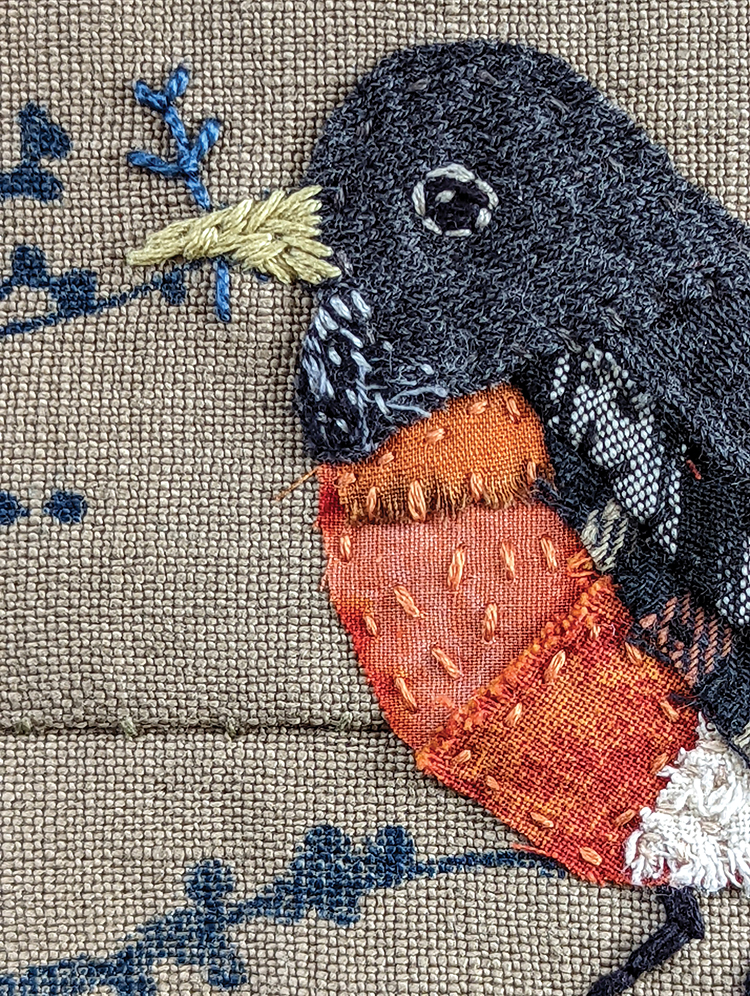
“Everything in nature invites us constantly to be what we are.”
—Gretel Ehrlich

Journey
If fuzzy memories are any indicator, my interest in wearable art started early. There I am, little preschool me, joyfully smearing fingerpaint with both hands. And not just on paper but clothing and possibly even walls, too. I feel like a party dress was involved, but maybe that’s just how I choose to remember it, since wearable art has occupied much of my creative energy over the years. One thing I do know is that creating art to wear feels as natural to me as painting a picture to hang on the wall. The art we create expresses who we are and how we see the world. What better way to embrace that than dressing up in our art for all to see?
Finger painting aside, the foundation for my wearable art dates back to when my grandmother pulled me on her lap and taught me to stitch. She had an abundance of patience, as grandmothers often do, and a winning strategy. First, she captured my attention with the decorative stitches, then came the hemming and buttons. A yellowing sampler she inspired still hangs in my studio. “Ann Smith, 8 years old,” it proudly proclaims in colorful, if slightly lopsided, chain stitch.

My mother kept a mending pile in an old wicker basket. It was actually less a pile, more a mountain, forever in danger of an avalanche. As soon as she recognized my interest in stitching, the mountain was my domain. And that was fine with me. Mom trusted me with the job, which meant adding my own flair. That mending pile was my first introduction to repair as self-expression — decades before we had any notion of “visible” mending the way we do now.
One summer, my best friend’s mother taught us to operate a sewing machine. Using a shared Simplicity pattern, we stitched calico jumpsuits with zipper fronts (it was the 1960s, after all). Those were the days of handlebars with streamers, and we made a statement biking the neighborhood in our handmade flower-power outfits. Wearable art might be stretching it, but the seeds were sown nonetheless.

I’ve been collecting interesting materials since I was a teenager and incorporating them into my work: fabric and buttons, ribbon and lace, vintage clothing and linens. I stitched coats from salvaged patchwork quilts; trimmed hand-sewn fleece jackets with batik prints and Bakelite buttons; and created handbags from hand-woven sari remnants. The notion of my work as art didn’t always occur to me. I simply made what I wanted to wear.
My current passion is repairing and upcycling garments I find in thrift shops, giving them a new look and another chance at life. We know so much now about the negative impacts of the fashion industry. And as someone who creates things to wear, I believe it’s important to think carefully before adding more to a world that’s already filled with clothing. It’s astonishing to see what people discard — cashmere sweaters with the tiniest stains, jeans with minimal wear. These castoffs are the basis for my art now. I sometimes wonder if my early interests were leading me here all along.
“Said the river: Imagine everything you can imagine, then keep on going.”
— Mary Oliver

I use various techniques to reimagine old garments. Sometimes I print on them with leaves I collect in our garden, using a process called botanical printing. I also repair worn areas with embroidery or patches. Sometimes I even cut them into pieces and rework them into something completely new, like a scarf or purse.
Reimagining an outdated garment is rarely a linear process from start to finish. There’s a lot of trial and error involved. I might start with a vision, but inevitably the vision evolves, sometimes unexpectedly, as I go along. Often I stitch an area only to rip everything out the very next day. Those moments are frustrating. But when I embrace the mistakes, the results are always better. Mistakes offer the best learning opportunities. I love the detours, when something happens that makes me completely question what I’m doing, and I end up taking an entirely different path. That’s what makes the creative journey so rich. I just need to remember to take a deep breath, trust my instincts and then jump in.
My work often incorporates hand stitching. I’m drawn to the meditative qualities of sewing slowly by hand. There’s something alluring about a project you hold in your lap that doesn’t require equipment or setup. It’s quiet and uncomplicated — soothing to mind and body. And when the stitching involves mending, there’s a whole other dimension. When I mend, I feel better, as if I’m somehow mended in the process, too.
I never know exactly where my art will take me next, but one thing I do know is that we live in uncertain times when so much feels beyond our control. I focus on what I can do, even if that’s only reimagining one garment at a time. I believe art can make a difference, and I want to be part of that.
Studio
My studio is the bedroom our daughters once shared. It’s the place where we used to create together when they were young, and the evidence remains: the sprinklings of glitter and the safety scissors. I love to surround myself with artifacts from my life and travels. It fuels my creativity.
Artwork and mementos hang on walls that are painted a bright Granny Smith-apple green. Childhood toys and a basket of baby shoes nestle next to jars of pens, pencils, scissors and paintbrushes. A bookshelf filled with how-to books stands in a corner next to a tower of bins stuffed with my voluminous and ever-expanding fabric collection. You’ll find containers everywhere, filled with odds and ends like buttons and beads, ribbon and thread. I collect things for my art — upcycled things — and my studio is filled to overflowing. My studio is a warehouse of sorts. I create here, but it’s also where I keep my supplies. When I need more room to work, I often move out to the dining room table.
Garden
I think of our garden as an extension of my studio. It’s where I find my inspiration, whether that’s the birds I applique or the leaves I embroider. It’s also where I do my leaf printing. And in the morning, you’ll often find me sitting near our persimmon tree listening to the birds with a cup of tea and some hand stitching.
“All my life through, the new sights of nature made me rejoice like a child.”
—Marie Curie
Wearable Art
When I sit down to reimagine a garment, I rarely have a set outcome in mind. Each garment comes with a story — and sometimes even a sewn-in name tag. My task, as I see it, is to add a new chapter.
One of my favorite ways to cover wear and tear, especially stains, involves printing over them with leaves. The technique, botanical printing, transfers the natural dyes in leaves to fabric. Basically, you roll leaves up in a pre-mordanted garment, then apply heat to transfer the natural dye and prints. It’s absolutely stunning. For lasting results, it’s important to follow a prescribed process; and if you want to learn more, I suggest starting with a class.
Once I’ve printed a piece, it’s time to repair the holes. I like to celebrate a garment’s longevity and service by drawing attention to the mending. Many of us call this visible mending, and unlike the mending my grandmother taught me, this mending stands out. It makes a statement. I carefully stitch or darn the hole. Then I add nature-inspired embroidery on top.
Patching is another great way to mend — and to use up even the tiniest fabric scraps. I love using leaf patches in my work, and during the pandemic, I started creating appliqued bird patches, too. They’re the perfect size for covering up large areas of wear. I also sew them on purses and pouches I make from upcycling offcuts.
“Life is a great big canvas and you should throw all the paint on it you can.”
– Danny Kaye
Sometimes garments need styling changes. I might cut off a dated turtleneck, sleeves or whatever feels necessary to update the look. It’s important to approach this step carefully. Once you cut into a garment, there’s no turning back. But luckily, the worst that can happen is that you end up with some luscious fabric for a future project. And that’s actually pretty wonderful.
Besides the visible mending, I usually add decorative stitching, too. It’s all about creating a cohesive piece, and if the mending is in an odd spot, like an armpit, for instance, a bit of extra stitching adds the balance that’s needed.

“Everything in nature invites us constantly to be what we are.”
—Gretel Ehrlich






